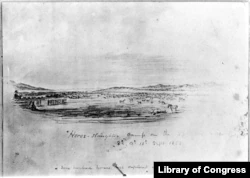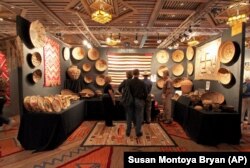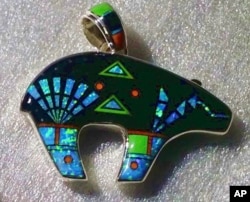Here is a summary of Native American-related news around the U.S. this week:
Air Force Base in Washington State to Rename Housing Units
Fairchild Air Force Base in Washington State has announced it will change the names of all parts of the base named after George Wright, a 19th-century Army general with a record of unusual cruelty against tribes in the northeast of the state.
“We are renaming Ft Wright Village and Ft Wright Oval in base housing to Lilac Village and Willow Loop,” Fairchild Air Force Base posted on Facebook Monday. “This change is the result of long consideration by Fairchild leadership, in accordance with an Air Force directive to evaluate historically divisive names on installations.”
In the autumn of 1858, then-Colonel Wright launched a two-month campaign against the Spokane, Palouse and Coeur d’Alene tribes to avenge an Army defeat several months earlier.
Donald Cutler, in his book “Hang Them All”: George Wright and the Plateau Indian War, 1858, described Wright’s strategy for dealing with tribes, writing, “Col. Wright, by admitting his intent was to strike fear into the tribes, showed that he understood the power of cruelty.”
Wright captured and slaughtered 900 Indian horses, burned tribes’ crops and food supplies, and staged public hangings that Cutler describes as “theatrically gruesome.”
Fairchild’s announcement generated some criticism on Facebook, coming amid vigorous debate in the U.S. about history, democracy and patriotism in America, which has seen the removal of dozens of Confederate and Christopher Columbus statues and reviews of the way history is being taught in some school districts.
In 2021, the city of Spokane, Washington, renamed a street that formerly carried Wright’s name. The new name is Whistalks Way, after a Spokane woman warrior who played a key role in resisting Wright.
Air Force erasing decorated Union Army veteran from base over ‘brutal acts’ towards Native Americans
Labor Department to Boost Native American Employment, Training Programs
The U.S. Department of Labor has announced the award of $70.8 million in grant funding to 166 Indian and Native American tribes and organizations to help provide employment and training services to low-income and unemployed Native Americans, Alaska Natives and Native Hawaiians to help them compete in today’s workforce.
Of the funds awarded, $56,351,790 will serve low-income and unemployed American Indians, Alaska Natives and Native Hawaiians. The remaining $13,932,627 will serve low-income American Indian, Alaska Native or Native Hawaiian youth ages 14-24 living on or near Indian reservations or in Hawaii.
The unemployment rate for American Indians and Alaska Natives has declined since April 2020, the start of the COVID-19 pandemic, when it hit 28.6 percent, nearly double the seasonally adjusted rate of 14.7 percent for the total population.
The lack of employment and/or educational opportunities in or near Indian reservations is one of the biggest challenges to tribal well-being today. In February, for the first time ever, the Bureau of Labor Statistics published data showing that the Native American unemployment rate in December 2021 was 7.9 percent, a rate much higher than the rate of 3.9 percent for the general U.S. population.
US Department of Labor awards $70.8M in grants to expand employment, training services for low-income, unemployed Native Americans
Cherokee Lawmaker is GOP Nominee for US Senate Seat
Conservative U.S. Representative Markwayne Mullin of Oklahoma, a citizen of the Cherokee Nation, this week won the Republican nomination for the Senate seat currently held by James Inhofe, who is set to retire at the end of the year.
In November midterm elections, Mullin will face off against the Democratic candidate, former U.S. Representative Kendra Horn.
Mullin, a businessman and former mixed martial arts fighter, is widely viewed as the favorite in Oklahoma, where Republicans control the offices of governor, secretary of state, attorney general and both chambers of the state Legislature.
Markwayne Mullin wins Republican bid for U.S. Senator Inhofe’s seat
Wailaki Astronaut to Head for the Stars
As a former Marine Corps test pilot, Nicole Aunapu Mann, a Wailaki citizen of the Round Valley Indian Tribes in Northern California, has flown on many missions, but none can compare to the flight she’s about to undertake next month: commanding a crew of five on a SpaceX flight to the International Space Station.
Once she reaches the ISS, she’ll spend six months conducting science experiments.
“One of the ones that I’m looking most forward to is called the biofabrication facility. And it is literally 3D printing human cells,” she told Jourdan Bennett-Begaye, editor of Indian Country Today.
Scientists have long envisioned using 3D biological printers to print human organs, but they’ve found it nearly impossible to print finer tissue, such as capillaries, in Earth’s gravitational environment. That’s because gravity flattens and deforms 3D-printed tissue. But in space, the lack of gravity allows 3D printed tissues to hold up.
Flying with Mann will be NASA astronaut Josh Cassada, Japan Aerospace Exploration Agency astronaut Koichi Wakata and Russian cosmonaut Anna Kikina.
In 2002, John Herrington of the Chickasaw Nation in Oklahoma became the first Native American in space.
September’s space trip may not be Mann’s last: In 2020, she was also selected to be one of a group of eligible astronauts to travel to the moon as part of NASA’s Artemis program.
First Native woman in space
Pueblo Potter Takes Top Prize in Santa Fe Indian Market
Over the weekend, the Southwestern Association for Indian Arts announced winners of the 100th annual Santa Fe Indian Market in New Mexico, the largest Native North American art market in the world.
San Ildefonso Pueblo potter Russell Sanchez won best in show — and a $30,000 award — for a lidded clay jar described as a contemporary interpretation of traditional Pueblo craftsmanship.
A bear stands atop the lid, an animal the Pueblo people associate with strength and protection. Winding around the center of the jar is the deity Avanyu, a plumed water serpent to whom Sanchez’s ancestors appealed to in times of drought.
Sanchez still fires his clay pieces outdoors in the traditional Pueblo manner, using cedar and dried cow or horse dung as fuel. He then carves, paints and polishes his pieces, which are inlaid with minerals and gemstones.
Navajo silversmith Ernest Benally won best in the jewelry category for a belt made of a dozen turtles, each embedded with turquoise, lapis lazuli and other gemstones.
To see the full list of winners in 10 categories, click on the link below; to see photos of the winning artworks, visit SWAIA’s Facebook page.
Santa Fe Indian Market Announces Centennial Best of Show Winners
Digital Solution Aims to Thwart Counterfeiters of Native Art
In a related story, counterfeit Native American art is a big problem in the U.S. and abroad. Jewelry, paintings and crafts falsely marketed as Native-made make big money for fraudsters but drive down the value of genuine Native art and denies Native artists a livelihood.
In one highly publicized case, federal investigators in 2015 raided 11 jewelry and Indian arts stores in New Mexico and California, seizing 350,000 pieces of Filipino-made jewelry with a retail value of $35,000,000.
This week, the art security registry Imprint announced it would partner with the Southwestern Association for Indian Arts to supply 800 Native American artists with permanently certified Imprint digital titles to their artwork.
Imprint gives artists and galleries permanent digital titles that allow them to officially register and create a digital certificate of authenticity that will be stored on a secure blockchain database — a digital “ledger” of all art transactions.
This means that buyers of Native artwork can be sure that they are getting works by legitimate Native artists, not frauds. Squeezing out the fakes means that genuine Native artworks retain or increase their value.
“When Imprint approached us to launch their blockchain-based art security registry with SWAIA artists, we immediately recognized the opportunity as one that will help combat theft and counterfeit within the Native American art world,” said SWAIA Executive Director Kimberly Peone, an enrolled member of the Confederated Tribes of the Colville Reservation in Nespelem, Washington, and an Eastern Band of Cherokee descendant. “We are thrilled to be able to provide cutting-edge solutions to SWAIA artists.”
The Indian Arts and Crafts Act of 1990 was intended to protect Native American artists by imposing fines and prison time for counterfeiting. Any individual falsely selling or presenting work as Native American can face civil or criminal penalties up to a $250,000 fine and/or a five-year prison term; any business selling fakes can face civil penalties or can be prosecuted and fined up to $1,000,000.
Imprint, SWAIA Partner to Combat Counterfeit Native American Art With Launch of New Digital Art Registry







